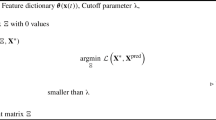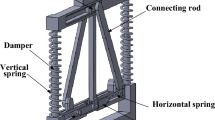Abstract
Modal identification involves estimating the modal parameters, such as modal frequencies, damping ratios, and mode shapes, of a structural system from measured data. Under the condition that noisy impulse response signals associated with multiple input and output locations have been measured, the primary objective of this study is to apply the local or global noise removal technique for improving the modal identification based on the polyreference time domain (PTD) method. While the traditional PTD method improves modal parameter estimation by over-specifying the computational model order to absorb noise, this paper proposes an approach using the actual system order as the computational model order and rejecting much noise prior to performing modal parameter estimation algorithms. Two noise removal approaches are investigated: a “local” approach which removes noise from one signal at a time, and a “global” approach which removes the noise of multiple measured signals simultaneously. The numerical investigation in this article is based on experimental measurements from two test setups: a cantilever beam with 3 inputs and 10 outputs, and a hanged plate with 4 inputs and 32 outputs. This paper demonstrates that the proposed noise-rejection method outperforms the traditional noise-absorption PTD method in several crucial aspects.
Similar content being viewed by others
References
Ewins D J. Modal Testing: Theory, Practice and Applications. 2nd ed. Baldock, Hertfordshire, England: Research Studies Press, 2000
Maia N, Silva J, He J, et al. Theoretical and Experimental Modal Analysis. Taunton, Somerset, England: Research Studies Press, 1997
Allemang R J, Brown D L. A unified matrix polynomial approach to modal identification. J Sound Vib, 1998, 211(3): 301–322
Cunha A, Caetano E. Experimental modal analysis of civil engineering structures. Sound Vib, 2006, (6): 12–20
Allemang R J, Brown D L. Experimental modal analysis and dynamic component synthesis, vol. 3 modal parameter estimation. Technical Report Contract No. F33615-83-C-3218, AFWAL-TR-87-3069, USAF, 1987
Braun S, Ram Y M. Determination of structural modes via the prony method: system order and noise induced poles. J Acoust Soc Am, 1987, 81: 1447–1459
Brown D L, Witter M C. Review of recent developments in multiple-reference impact testing. Sound Vib, 2011, (1): 8–16
Juang J N. Applied System Identification. Englewood Cliffs, NJ: PTR Prentice Hall, 1994
Van Overschee P, De Moor B. Subspace Identification for Linear System: Theory, Implementation, Applications. Dordrecht: Kluwer Academic Publishers, 1996
Peeters B, De Roeck G. Stochastic system identification for operational modal analysis: A review. J Dyn Syst Measur Control, 2001, 123(4): 659–667
Hu S-L J, Bao X X, Li H J. Model order determination and noise removal for modal parameter estimation. Mech Syst Signal Process, 2010, 24(6): 1605–1620
Chu M T, Funderlic R E, Plemmons R J. Structured low rank approximation. Linear Algebra Appl, 2003, 366: 157–172
Markovsky I, Van Huffel S. Overview of total least squares methods. Signal Processing, 2007, 87(10): 2283–2302
Heylen W, Lammens S, Sas P. Modal Analysis Theory and Testing. Leuven, Belgium: Katholieke Universiteit Leuven, 1997
Eckart G, Young G. The approximation of one matrix by another of lower rank. Psychometrika, 1936, 1: 211–218
Cadzow J A. Signal enhancement—A composite property mapping algorithm. IEEE Trans Acoust Speech Signal Processing, 1988: 36(1): 49–62
Tufts D, Shah A. Estimation of a signal waveform from noisy data using low-rank approximation to a data matrix. IEEE Trans Signal Process, 1993, 41(4): 1716–1721
De Moor B. Total least squares for affinely structured matrices and the noisy realization problem. IEEE Trans Signal Process, 1994, 42(11): 3104–3113
Author information
Authors and Affiliations
Corresponding author
Rights and permissions
About this article
Cite this article
Hu, SL.J., Bao, X. & Li, H. Improved polyreference time domain method for modal identification using local or global noise removal techniques. Sci. China Phys. Mech. Astron. 55, 1464–1474 (2012). https://doi.org/10.1007/s11433-011-4625-1
Received:
Accepted:
Published:
Issue Date:
DOI: https://doi.org/10.1007/s11433-011-4625-1




